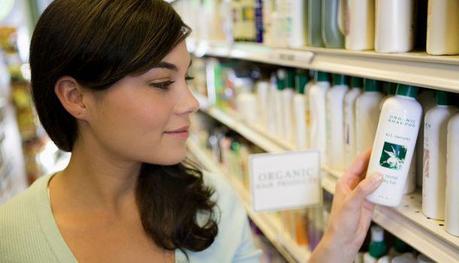
Whether it’s staying in shape, deciding to be more frugal, or going green, changing your lifestyle’s never that easy. You’re so set in your ways, and it takes incredible willpower to stick to your new plan. (I’m foolishly trying to do all three of the above – you can imagine my stress right now!) While some people feel going green and eco-friendly means having to overhaul your entire life, you don’t have to do so right away. That’s overwhelming. But, you can start small – just as with your beauty and personal care products!
Today, I’m going to explain 5 easy methods you can utilize today while you go natural. It’ll take some time to complete them all, but like losing those last 5 pounds – you’ll feel fantastic when you do!
1. Determine your allergies to herbs, food, nuts, etc.
A lot of people forget that any food, herb, plant, or nut allergies also apply to your beauty products. Natural, organic, and green beauty products tend to use a lot of the aforementioned, so before you dive in and go crazy on a shopping spree, figure out what your allergies are. You may know of your peanut allergy, but do you also remember the slight rash you got as a kid when you were given a little lavender flower? If you stayed away or had zero access to lavender since, you may think your body’s over it.
Don’t be fooled! Assume you’re still allergic, and get tested by a physician if you suspect any other allergies. There are many vegan and gluten-free beauty products available, and if you suspect any soy or nuts were used or somehow included in the product (even in trace amounts), always ASK! Better safe than sorry.
2. Determine your price range and budget
Buying natural beauty products can get pricey. While the prices are comparable to conventional brands found in department stores, the amounts are often less per ounce, and the shelf life’s usually half as long. Instead of constantly comparing the price of the natural product with the conventional one, figure out what your personal budget is and stick to it. You can also determine how long it takes you to use a product up.
For example, I cleanse my face twice a day. Depending on the formula, I use 1-2 pumps of product per wash. 6 ounces of cleanser can last me approximately 4 months. My personal budget towards a good, natural cleanser is 16.00. That’s ~4 bucks a month to keep my face clean and blemish-free – a small price to pay considering all the extra toxins I’m avoiding!
Some of you are willing to go all out, and that’s cool, too. Just don’t buy a 90.00 natural eye cream and think it’s superior in any way to a similarly formulated eye cream at a fraction of the price. At that point, you’re paying for the prestige, packaging, marketing and label, not the product.
3. Printout a list of ingredients you’d avoid, along with their alternate names
.. then try to memorize them, or as many as you can. I have a resource you can use to find out what risky ingredients to avoid in your beauty products, but we all have different thresholds and degrees of green. Some of us can not tolerate a particular ingredient at all, while another has no problem with it. For example, I don’t have any allergies to sulfates, and they don’t irritate my scalp or skin. I haven’t lost any hair from it either (quite the contrary – I’ve always had high density hair!) So, I may personally be a bit more forgiving to a gentler sulfate in my shampoo. You might not be – and that’s completely ok.
Personalize your list, and keep it handy when you go shopping, whether it’s in a brick and mortar or online, and if possible, memorize the very important ingredients. Common ones are parabens, phthalates, artificial dyes, sodium lauryl sulfate (or any sulfate), petroleum/mineral oil, synthetic fragrances, and propylene glycol.
4. Use up what you have first, then replace it with a greener, natural version
Like many of you, my beauty regimen was mostly conventional products. With life being so busy, I just grabbed what worked and was cheap at the drugstore, and maybe the occasional splurge at the department store. (I had a few natural products, but nothing close to what I use now). As I used up my old stuff, I started replacing it with a greener version, preferably certified organic. My facial moisturizer, cleanser, soap, body cream, and hand cream are some of the few products I’ve replaced within the past year or so.
Going natural shouldn’t mean heading to your local Whole Foods and plunking down 200.00 to overhaul your currently crowded bathroom. Note what you’d like to try or use to replace, then use up the old stuff first. That way, you’re slowly replacing your products,and not diving head first into something very new and potentially dangerous. (See number 1 for an explanation on that).
Now, if you can’t afford to replace them all, try replacing your body moisturizer first since it covers the most skin. Deodorant is another popular suggestion. We all have our favorite scents – I can almost guarantee you’ll find a natural version of the same scent somewhere.
5. Read label list of old product, find the active ingredient, then look for its natural replacement
The best way to get a as-close-as-you-can-get-it natural based replacement to your old product is to check the ingredients list. If there’s a specific emollient, humectant, or extract that you like and it’s listed within the first 6 or so ingredients, find the natural substitute with a bit of research. For example, your old product lists isopropyl palmitate as the emollient and propylene glycol as its humectant. Your new natural replacement can use jojoba oil as the emollient, and maybe glycerin as the humectant. They function the same way – attracts and hold moisture into your skin. The first two are un-natural and can cause skin irritations, but the latter (barring allergies) do not, and are natural based and safe.
Ready to get started?
Hopefully, these 5 tips will help when you finally start transitioning to using more natural beauty products. Regardless of what step you take, the first one is crucial. It gets easier from there – just like anything else in life!
If you liked this article, please Share it on Facebook, Add it to StumbleUpon, Pin it to Pinterest, or Tweet it on Twitter. Spread the word, and let’s help those on the fence to finally hop off and get started!

